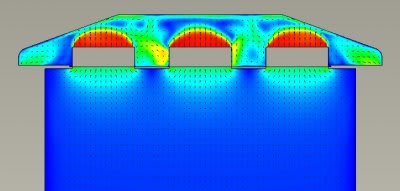What is CFD .. Science or Black Magic?
Follow articleHow do you feel about this article? Help us to provide better content for you.
Thank you! Your feedback has been received.
There was a problem submitting your feedback, please try again later.
What do you think of this article?
Introduction
As a leading thermal management company ebm-papst UK Ltd has recently invested in state of the art CFD analysis software. This is to support both our own design work and as a service we can offer to our customers.
ebm-papst UK Ltd has supported its customers with a complete design service for many years, traditionally this involved a number of steps design , build prototype, test , redesign , retest and finally qualification test. However with the modern software tools available it is now possible to cut-out much of the prototyping and most of the testing phases by performing virtual testing using CFD.
First of all a definition or two;
CFD = Computational Fluid Dynamics
CFD is one of the branches of fluid mechanics that uses numerical methods and algorithms to solve and analyze problems that involve fluid flow as well as heat and mass transfer.
Fluid dynamics
Fluid Dynamics is a field of science which studies the physical laws governing the flow of fluids under various conditions.
A little history
A great deal of research has gone into understanding the governing laws and the nature of fluids this has resulted in a complex yet theoretically strong field of research. Initially only universities and government organisations had both the computing power and the research staff to run the complex software and interpret the results, however the advent of high power desktop computers resulted in a number of commercial packages becoming available. Due to the software complexity CFD was initially regarded with more than a little distrust this lead to its 'Black Magic' image. However as its use became more widespread and easier to use it gained acceptance.
What does CFD do?
CFD enables us to understand the world in new ways. We can now see what it is like to be in the combustion chamber of a racing car engine, model how blood flows through our arteries and veins and even create virtual environments. CFD not only simulates the flow of gases and liquids but also includes heat and mass transfer, moving bodies, multiphase physics, chemical reaction, fluid-structure interaction and acoustics. CFD enables engineers to simulate a new product allowing 'What if' scenarios to be tried out without the need for expensive prototypes and testing.
What are CFD's benefits?
CFD can provide a unique insight into your design, CFD analysis enables you to virtually investigate your design and see how it performs. There are many phenomena that you can simulate through CFD, which wouldn't be possible by any other means.
The use of CFD helps you to design better and faster, as well as save money, meet increasingly stringent environmental regulations and ensure industry compliance. CFD analysis leads to shorter design cycles and consequently products get to market faster.
How does CFD work?
Initially the model of the part or product is constructed in a CAD system , this model is then used to generate the computational mesh which the CFD software uses to perform the calculations, the results of these calculations are used to generate graphs and visualisations to aid in verifying and validating the results.
There are four key stages to every CFD simulation;
- Preprocessing
- Solving
- Postprocessing
- Verify & Validate
Preprocessing
This is the first step in building and analysing a model.
- Model construction - building the model within a computer-aided design (CAD) package
- Meshing - creating and applying a suitable computational mesh
- Flow & Boundary conditions - entering the flow boundary conditions and fluid & materials properties
The image above shows the same view as the image at the start of this blog but with the mesh overlayed. Note that the density of the mesh varies depending on the geometry, this allows the solver to better calculate the conditions around fine geometry and in doing so produce a more accurate result. The set-up of the problem, e.g. application of the boundary and flow conditions, is one of the most critical steps and requires an engineer with a knowledge of the product being evaluated, fluid dynamics and the CFD application.
Solving
The CFD software performs the flow, heat transfer and associated calculations and generates the results data.
This process is the most computationally intensive and can take several hours depending on the model complexity.
Postprocessing
Postprocessing involves the organization and interpretation of the predicted flow and thermal data and the production of images and animations to illustrate the results in the report. The results will require an engineer with a comprehensive knowledge of fluid dynamics to interpret the results.
Verify & Validate
Probably one of the most overlooked aspects is the verification and validation of the results, without validation of the results either from previous work or from actual test data the CFD results shouldn't be relied upon.
Conclusion
I hope I've been able to provide you with an insight into the world of CFD and the many benefits that it can offer. I'll be posting further blogs with various case studies over the coming weeks. In the mean time if you have any questions feel free to contact me either via the comments or Twitter @peterjfrancis


